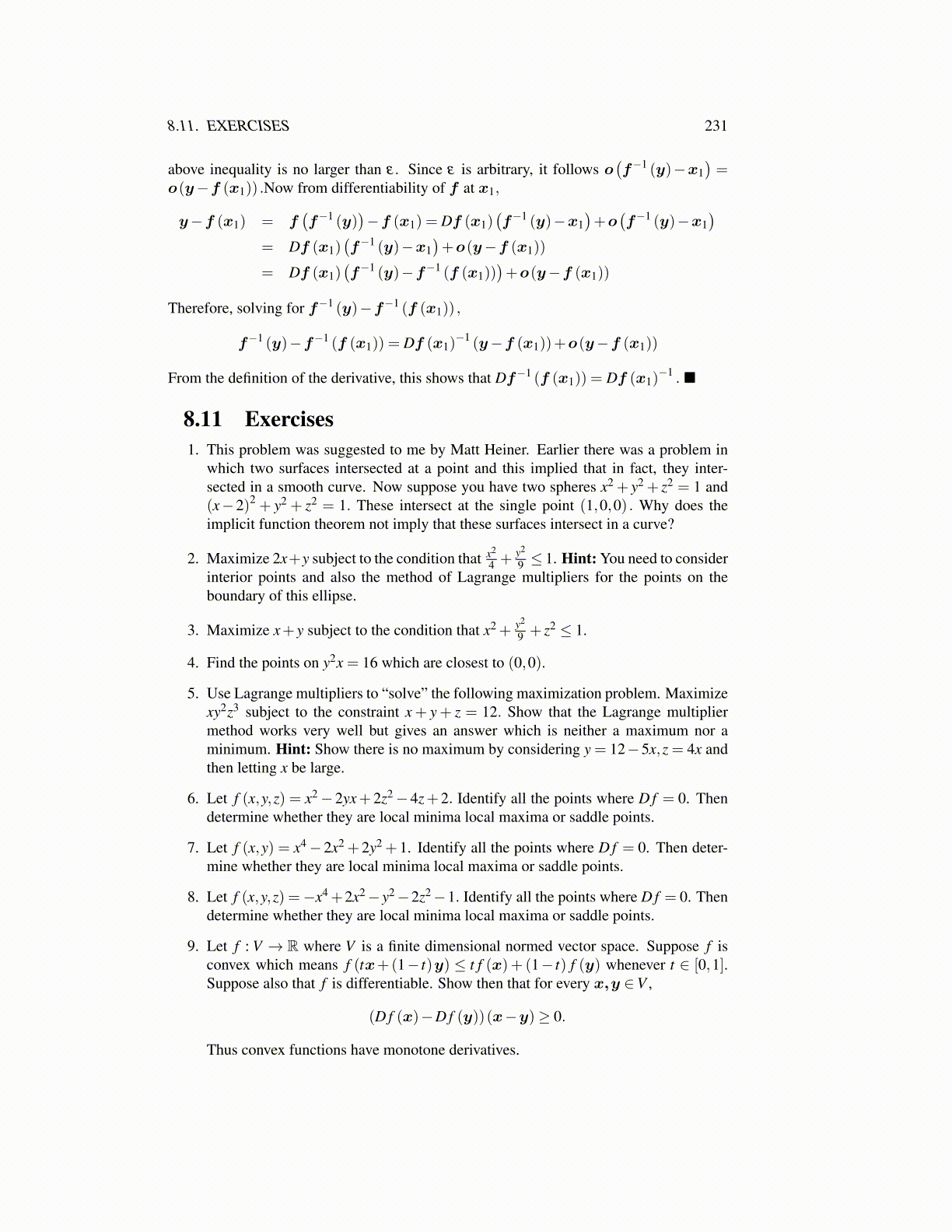
8.11. EXERCISES 231
above inequality is no larger than ε . Since ε is arbitrary, it follows o(f−1 (y)−x1
)=
o(y−f (x1)) .Now from differentiability of f at x1,
y−f (x1) = f(f−1 (y)
)−f (x1) = Df (x1)
(f−1 (y)−x1
)+o
(f−1 (y)−x1
)= Df (x1)
(f−1 (y)−x1
)+o(y−f (x1))
= Df (x1)(f−1 (y)−f−1 (f (x1))
)+o(y−f (x1))
Therefore, solving for f−1 (y)−f−1 (f (x1)) ,
f−1 (y)−f−1 (f (x1)) = Df (x1)−1 (y−f (x1))+o(y−f (x1))
From the definition of the derivative, this shows that Df−1 (f (x1)) = Df (x1)−1 . ■
8.11 Exercises1. This problem was suggested to me by Matt Heiner. Earlier there was a problem in
which two surfaces intersected at a point and this implied that in fact, they inter-sected in a smooth curve. Now suppose you have two spheres x2 + y2 + z2 = 1 and(x−2)2 + y2 + z2 = 1. These intersect at the single point (1,0,0) . Why does theimplicit function theorem not imply that these surfaces intersect in a curve?
2. Maximize 2x+y subject to the condition that x2
4 + y2
9 ≤ 1. Hint: You need to considerinterior points and also the method of Lagrange multipliers for the points on theboundary of this ellipse.
3. Maximize x+ y subject to the condition that x2 + y2
9 + z2 ≤ 1.
4. Find the points on y2x = 16 which are closest to (0,0).
5. Use Lagrange multipliers to “solve” the following maximization problem. Maximizexy2z3 subject to the constraint x + y + z = 12. Show that the Lagrange multipliermethod works very well but gives an answer which is neither a maximum nor aminimum. Hint: Show there is no maximum by considering y = 12−5x,z = 4x andthen letting x be large.
6. Let f (x,y,z) = x2− 2yx+ 2z2− 4z+ 2. Identify all the points where D f = 0. Thendetermine whether they are local minima local maxima or saddle points.
7. Let f (x,y) = x4−2x2 +2y2 +1. Identify all the points where D f = 0. Then deter-mine whether they are local minima local maxima or saddle points.
8. Let f (x,y,z) =−x4 +2x2−y2−2z2−1. Identify all the points where D f = 0. Thendetermine whether they are local minima local maxima or saddle points.
9. Let f : V → R where V is a finite dimensional normed vector space. Suppose f isconvex which means f (tx+(1− t)y) ≤ t f (x)+ (1− t) f (y) whenever t ∈ [0,1].Suppose also that f is differentiable. Show then that for every x,y ∈V ,
(D f (x)−D f (y))(x−y)≥ 0.
Thus convex functions have monotone derivatives.